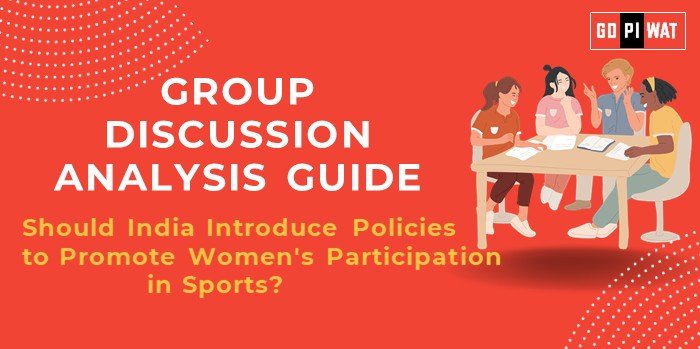📋 Group Discussion (GD) Analysis Guide: Should India Introduce Policies to Promote Women’s Participation in Sports?
🌐 Introduction to the Topic
Opening Context: Women’s participation in sports is a barometer of societal inclusivity and empowerment. Globally, countries with progressive sports policies see better gender equity in various domains.
Background: Despite successes like PV Sindhu and Mary Kom, women’s representation in Indian sports remains limited due to systemic barriers. Policies promoting women’s participation could pave the way for societal change and economic opportunities in the sports industry.
📊 Quick Facts and Key Statistics
- 📉 Gender Gap in Sports Participation: Only 15% of athletes representing India in major international competitions are women.
- 💰 Economic Potential: The global sports industry is worth $620 billion, yet women account for less than 20% of this economic activity.
- 🎓 Education-Sports Link: Girls in schools with sports programs are 1.5 times more likely to complete secondary education.
- 📺 Success Stories: India’s women’s cricket team saw a 300% increase in viewership between 2020 and 2023.
🌍 Stakeholders and Their Roles
- 🏛️ Government: Funding, infrastructure, and inclusion policies (e.g., Khelo India Scheme).
- 🏢 Sports Federations: Addressing gender disparities in coaching and team selection.
- 💼 Private Sector: Sponsorships, endorsements, and grassroots programs.
- 📺 Media: Highlighting women athletes and providing equal coverage.
- 👩👩👧👦 Society: Overcoming stereotypes and supporting women athletes.
🏆 Achievements and Challenges
✨ Achievements
- 🏸 Inspiration: PV Sindhu’s Olympic medals inspired a 40% increase in badminton enrollment among girls.
- 🏏 Financial Support: BCCI’s central contracts for women cricketers boosted financial security.
⚠️ Challenges
- 🏗️ Infrastructure: Only 30% of sports facilities cater to women.
- 🛡️ Safety: Lack of safe spaces and harassment deter participation.
- 💵 Pay Gap: Male athletes earn 4–5 times more in endorsements and salaries.
🌍 Global Comparisons
- 🇳🇴 Success: Nordic countries see 50% female participation in sports due to inclusive policies.
- 🇧🇷 Challenges: Brazil struggles with similar issues despite robust football culture.
💬 Structured Arguments for Discussion
- ✅ Supporting Stance: “Policies promoting women’s participation in sports can drive societal and economic benefits, bridging gender gaps.”
- ❌ Opposing Stance: “Focusing on sports policies diverts attention from fundamental issues like education and healthcare for women.”
- ⚖️ Balanced Perspective: “While policies are essential, they should be accompanied by societal mindset shifts and grassroots efforts.”
🎯 Effective Discussion Approaches
- 💡 Opening Approaches:
- “With only 15% representation in Indian sports, isn’t it time for targeted policies?”
- “Globally, inclusive sports policies have transformed gender equity. Shouldn’t India follow suit?”
- 💡 Counter-Argument Handling:
- “While education is vital, sports enhance education outcomes, promoting all-round development.”
🔍 Strategic Analysis of Strengths and Weaknesses
- 💪 Strengths: Rising awareness, successful role models, increased funding.
- 📉 Weaknesses: Safety concerns, limited infrastructure, societal stereotypes.
- 📈 Opportunities: International recognition, economic growth, and health benefits.
- ⚠️ Threats: Cultural resistance, policy implementation gaps.
🎓 Connecting with B-School Applications
- 📌 Real-World Applications: Business models for sports startups targeting women, CSR initiatives.
- 💡 Sample Interview Questions:
- 🤔 “How can policies in sports empower women economically?”
- 🤔 “What role do private organizations play in promoting gender equality in sports?”
- 📚 Insights for Students:
- 🌟 Building case studies on successful policies and analyzing market dynamics of women’s sports.
📄 Source: Comprehensive Analysis, 2024


